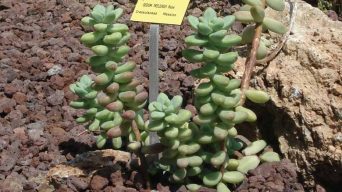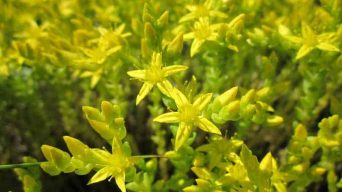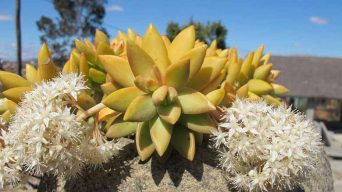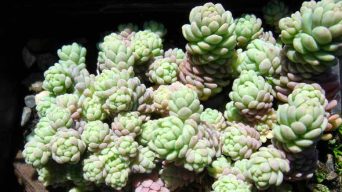The Sedum Adolphii succulent plant (or, more commonly known as the Golden Glow Sedum) is a popular houseplant. Still, it can also be grown outdoors in mild climates.
They are hardy, low-maintenance plants that can be grown easily in a variety of conditions.
However, some people may still need help caring for their sedum varieties and propagating them into new plants.
This guide will show you how to care for your Sedum Adolphii and propagate it into new plants!
How To Care for Sedum Adolphii (Golden Sedum)
Sun Exposure & Light Requirements
Sedum Adolphii plants need full sun exposure and an abundance of light.
They are challenging to grow indoors in partial shade but can be grown as a houseplant with the right conditions.
- The Sedum plant will not do well in shaded areas or spots that lack adequate sunlight for more than six hours per day.
- Provide bright light during the day and a location in which it can receive indirect light at night, such as near a window with partial sun exposure.
- It will grow best in an east or west-facing windowsill that receives full to part sunlight for most of the day.
The Sedum does not do well if objects like plants, buildings, or curtains shade its succulent leaves.
If placed too close to other items, its growth may be stunted due to insufficient access to nutrients and air circulation.
Watering
Water the plant when it is dry. The soil should drain freely and not be water-logged or flooded but moist all through.
If you’re unsure if this means your Sedum needs to be watered, dig down about an inch below the surface of the potting mix. If it’s still wet, then don’t water it yet!
When watering in containers, use enough so that most of the roots are wet without letting them get soggy for more than a few minutes.
Don’t underestimate how thirsty these plants can be. They’ll take up as much as six inches of liquid-like nothing.
Keep in mind that since sedums come from places with high humidity levels (even those that originate in deserts!), they often need more water than other hardy succulents.
Don’t be afraid to give your Sedum a drink of water if you think it needs one. These plants are pretty resilient!
They may turn brown or start drooping, but this is due to thirst and not being overcrowded with too many roots.
Try watering once again before giving up on the plant altogether.
However, if it doesn’t recover within 24 hours, consider repotting it into something larger that can accommodate its root system.
Sedum species thrive best when their potting soil dries out slightly between watering sessions. Make sure never to let them sit overly moist for long periods (more than 12 hours).
For those who live in humid or tropical climates, it may be necessary to use a porous material such as coconut coir or peat moss in the potting mix to help with drainage.
Soil
The soil should be sandy and loose to allow the roots of the Sedum adolphii plant to grow easily.
Ensure that the pot has a drainage hole at the bottom so water can drain out when it rains or is watered.
A coarse gravel layer on top will help keep moisture in for long periods without adding more water.
Still, you also want some holes with larger cavities where excess water can escape as well.
In general, you want to use a potting mixture that drains well. This will allow the plant’s roots to receive plenty of oxygen and avoid rotting while still allowing moisture in the soil for healthy root growth.
Temperature and Humidity
Just because a succulent plant can survive outdoors does not mean they are tolerant of extreme weather conditions.
Sedum Adolphii is no exception. Its care must be monitored during cold winters or hot summers to make sure it remains healthy and content.
The ideal temperature for Sedum Adolphii is 15°-25°C (59°-77°F). It should be kept at a minimum of 12º C (53.54º F) during the winter to avoid damage or death through freezing when temperatures drop below this level.
In summer, it needs between 18º and 24º C (64.44º -75.84 º F), with an average daytime temperature of 25 °C (77 °F).
The ideal humidity level for the Sedum Adolphii plant is 40-60%. This can be achieved by misting it regularly and having it near a window with an open door or in a room humidifier.
Too much water, on the other hand, will lead to the rotting of roots, so care should be taken not to overdo this measure.
The average daytime temperature combined with regular irrigation makes achieving these levels simpler than during winter when light levels are lower, and the air is drier.
You must keep your plant away from strong drafts during any season: if possible, put them on the leeward side of buildings so they don’t get too cold or hot, either way, causing harm to their health.
This can also prevent the Sedum Adolphii succulent plant from getting dehydrated.
In winter, one of the most common problems for plants is that they get wet and then dry out too much.
This causes them to lose their leaves and eventually die if moisture levels are not maintained at a certain level.
Try raising your pot off the ground with pebbles or rocks so that it doesn’t stay in contact with water on the ground.
This will help prevent any dampness from drying out its roots during cold nights when you can’t provide enough warmth and humidity to keep it alive.
Fertilizing Sedum Adolphii
In order to get the best growth of Sedum Adolphii, you must fertilize your plant regularly.
For succulents like this one, a water-soluble fertilizer will work just fine.
It’s recommended that you use approximately ½ teaspoon per gallon of water and mix with every watering until they are established in their new home for at least three months.
New plants should be fed an additional ¼ teaspoon each week using the same method as before.
The soil pH level should also be checked. The pH level is too low if it falls under six or seven.
This can cause iron chlorosis, which leads to leaves that are yellow and growth is stunted. If so, calcium could either need to be added to the soil, or some foliar spray could be applied to improve this.
Potting and Repotting
The pot you place your Sedum in is critical and should be filled with a porous soil mix.
You need to ensure the surface has been sterilized so it doesn’t contain any pests or diseases which can harm your succulent plant.
The potting mix should have a good loam, peat, sand, and coarse perlite ratio. You will need around one part each for the first three ingredients in relation to two parts of perlite.
The mixture needs to be moistened before you place your Sedum into it so that it is soft enough for them. Avoid adding anything else. This could lead to rot or significant damage if any fertilizers or pesticides were added instead of just water.
The pot should have drainage holes in the bottom so that excess water can be drained away.
The Sedum will need to stay moist but not wet at any time, which will prevent root rot or other issues.
You can either water the plant from below with a watering can and let it drain away or use a pebbled tray to facilitate drainage.
It is important that when transplanting, you should get your Sedum accustomed to its new surroundings first before putting them in its permanent spot.
This will give them time to adjust without any major shock, and they will be less likely to suffer from stress which would lead to problems later on.
When planting your succulent, choose an area where it has room for expansion and protection from harsh winds or direct sunlight if possible.
The sunnier areas will require more frequent watering, so this means not too close but not too far away since soil needs to dry out between waterings.
If you let your Sedum go dormant, it is best to place them in a cool area such as an unheated garage or porch during winter. Just water enough for their needs at that time of year.
Pruning
Pruning Sedum adolphii is unnecessary, but doing so has some benefits. It can help prevent the plant from becoming too large and thick in certain areas.
Pruning allows for more air movement around the plants’ surface (and potentially reduces water loss).
It also allows you to make better use of your space. If a succulent has grown outwards past its container’s edge, prune it back at that point!
Sedums don’t form their growth tips into buds like other cacti or succulents.
They grow outward on stolons. This means that new green shoots will continue growing up from where the cut was made when you cut them down with pruning shears.
Be sure to water the plant afterward to heal and prevent further issues with rot or disease from setting in on the plants’ wounds.
Pests and Diseases
Pests and diseases are not usually a problem with Sedum adolphii plants.
The most common pests that plague sedum plants are:
- Aphids
- Mealybugs
- Mites
- Scale insects
- Whiteflies.
If you notice any insects on your plant, the best way to approach it is by picking off the individual bugs or spraying the leaves with water from a spray bottle.
Insecticides will need to be sprayed onto each leaf to kill all of them at once. They should only be used if necessary because overuse can also cause damage to plants.
The most common diseases that affect sedum plants are:
- Leaf spot
- Powdery mildew
- Rust and canker
These diseases are most common in warmer weather, so ensure your plant always gets plenty of water to avoid them!
How To Propagate Sedum Adolphii (Golden Sedum)
The Sedum Adolphii (Golden Sedum) is a perennial succulent plant that thrives in sun and dry conditions. There are many ways to propagate the Golden Sedums:
Cuttings From Branches
Take the Sedum cuttings and place them on top of the soil with lower leaves touching the surface, but do not cover the stem or leave any leafless spots uncovered by the soil.
Offsets/Pups
Remove offsets gently without tugging at roots and pot into individual pots with proper drainage. Divide larger clumps when they have grown large enough so there’s too much for one container.
They can also be propagated by taking three or four offsets or “pups” at once.
A good propagation time is when the plants are in their second year and have produced enough offsets to make dividing necessary.
Collect Sedum Seeds
Let mature flowers go to seed, then harvest several weeks later. Sow outdoors once it has cooled.
The Sedum Adolphii succulent plant can also be spread by scattering its seeds after they mature into flowering plants around your garden area.
Collect Stem Cuttings
Collect and grow from thimble-sized pieces of stems called leaf rosettes. Pot them in a light, sandy soil mix.
Take Cuttings From Leaves
Leave the green part below (so it will eventually produce roots), then place it on top of the soil with lower leaves touching the surface.
Toxicity
Sedum Adolphii, like other succulents in the Sedum genus variety, are not toxic to pets or humans.
It is also non-toxic and safe for children with skin allergies. It does not possess any common allergens found in most houseplants (ragweed pollen; dust mites).
Final Thoughts
The Sedum Adolphii succulent plant is a beautiful and attractive addition to any garden.
It’s easy to care for, but due to its particular needs may require extra attention in the winter season.
Whether it be propagating or caring for this lovely plant, you can enjoy your new friend in many ways!







